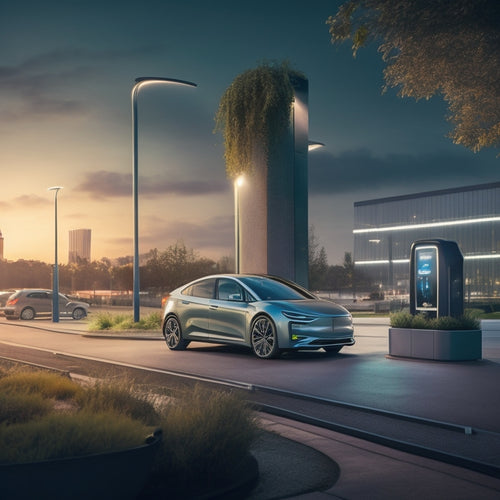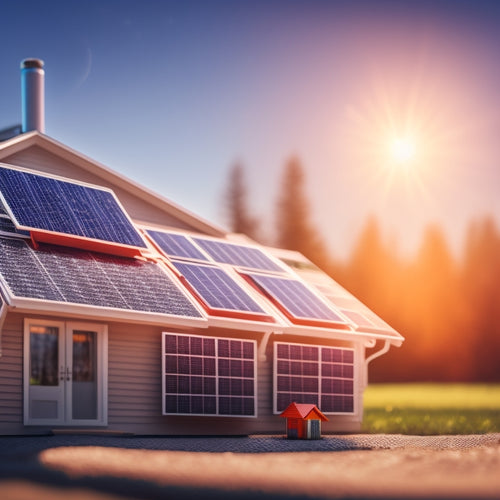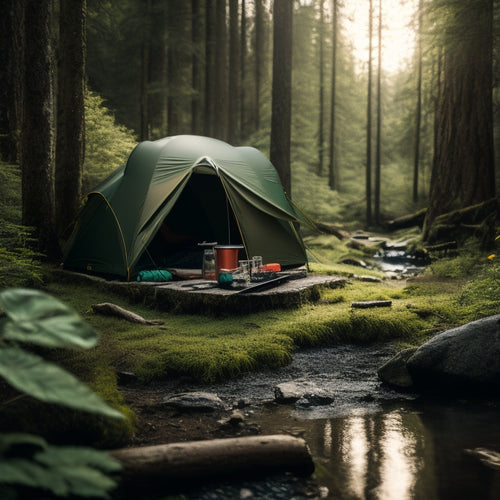
10 Ways to Green Your Home Efficiently
Share
You're taking the first step towards creating a more sustainable and eco-friendly home, and it starts with making a few simple yet impactful changes. Begin by utilizing natural light, sealing air leaks, and upgrading to LED lighting to reduce energy consumption. Next, invest in Energy Star appliances and insulate your home properly to minimize heat loss. Improve your home's ventilation, add solar power to your roof, and use power strips wisely to eliminate standby power consumption. Conduct regular energy audits to identify areas for improvement. By incorporating these 10 ways to green your home efficiently, you'll be well on your way to a more eco-friendly living space, and there's even more to uncover.
Key Takeaways
- Upgrade to LED lighting to reduce energy consumption by up to 90% and lower utility bills.
- Invest in Energy Star appliances to reduce energy consumption and promote sustainability.
- Conduct regular energy audits to identify areas of high energy consumption and make adjustments.
- Insulate your home properly with sustainable materials to reduce heat loss and energy waste.
- Implement water conservation strategies like rainwater harvesting and low-flow fixtures to minimize water usage.
Harness Natural Light Effectively
By strategically placing mirrors and reflective surfaces, you can maximize the natural light that pours into your home, reducing the need for artificial lighting and saving energy in the process.
This simple trick allows you to reap the natural light benefits, making your home feel brighter and more welcoming.
By incorporating solar-powered shelving units in your kitchen, you can also reduce your reliance on non-renewable energy sources and lower your electricity bills.
Ideal window placement is also essential, as it enables natural light to pour in from multiple angles.
Consider replacing heavy curtains with light, airy alternatives to further enhance the effect.
Seal Air Leaks Everywhere
Around every door and window, gaps and cracks can be sneaky energy saboteurs, quietly letting heat escape and cold air seep in. To detect air leaks, you can perform a simple DIY test: turn off all fans and appliances, hold a lit candle or incense stick near potential leak areas, and watch for flickering or drifting smoke. Once you've identified the leaks, it's time to seal them up.
| Sealing Material | Best For | Cost |
|---|---|---|
| Caulk | Gaps around windows, doors, and trim | $5-$10 |
| Weatherstripping | Door and window seals | $10-$20 |
| Spray Foam | Large gaps and holes | $20-$50 |
Choose the right sealing material for the job, and get to work. By sealing air leaks, you'll save energy, reduce your utility bills, and create a cozier, more comfortable living space.
Upgrade to LED Lighting
You're about to brighten up your home while cutting energy costs when you upgrade to LED lighting.
With LED bulbs, you'll enjoy brighter energy savings ahead, thanks to their outstanding energy efficiency.
Plus, these longer lasting light bulbs will reduce your replacement frequency, making them a convenient choice for your green home.
Brighter Energy Savings Ahead
Inside your home, a simple switch to LED lighting can make a significant impact on your energy consumption. By replacing traditional incandescent bulbs with LEDs, you'll not only reduce your energy usage but also lower your utility bills.
In fact, LED lighting uses up to 90% less energy than traditional lighting. This switch can also complement other energy-saving efforts, such as installing a smart thermostat, which can learn your schedule and preferences to optimize heating and cooling.
Additionally, consider energy efficient landscaping, which can reduce the need for outdoor lighting altogether. By making these changes, you'll be well on your way to a more energy-efficient home.
Longer Lasting Light Bulbs
Making the switch to LED lighting is a no-brainer, especially when you consider the impressive lifespan of these bulbs.
You'll enjoy considerable energy savings and reduce your environmental impact. Here's what you need to know:
-
Longer lifespan: LED bulbs can last up to 25 times longer than traditional incandescent bulbs, reducing the need for frequent replacements and waste.
-
Eco-friendly materials: LEDs are made with recyclable materials and are free of toxic chemicals like mercury, making them a more sustainable choice.
-
Energy efficiency: LED bulbs use considerably less energy than traditional bulbs, reducing your energy consumption and saving you money on your utility bills.
Insulate Your Home Properly
You'll be surprised at how much energy you can save by insulating your home properly. By reducing heat loss, you'll keep your home warmer in the winter and cooler in the summer, which translates to lower energy bills.
For instance, using sustainable insulation options like recycled denim, natural wool, or soy-based foam can minimize heat loss and energy waste.
Now, let's investigate the different types of insulation and identify gaps in your home's insulation to maximize its effectiveness.
Reduce Heat Loss
This winter, your wallet and the environment will thank you if you reduce heat loss by insulating your home properly.
You can start by identifying areas where heat escapes and addressing them with the right solutions.
- Install thermal curtains or energy efficient windows to minimize heat loss through glass.
- Use radiant barriers in your attic to reflect heat back into your home.
- Seal gaps and cracks with weather stripping and draft stoppers to prevent heat from escaping.
Proper Insulation Types
Now that you've identified areas where heat escapes, it's time to choose the right insulation materials to keep the warmth in.
Fiberglass insulation is a popular and affordable option, suitable for walls, floors, and ceilings. It's available in batts or blankets, making it easy to install. However, it may not be the most effective choice for tight spaces or areas prone to moisture.
For those areas, consider spray foam insulation, which expands to fill gaps and provides a high R-value. It's more expensive than fiberglass, but its durability and performance make it a worthwhile investment.
When selecting insulation materials, consider factors like climate, budget, and personal comfort to guarantee you're getting the best fit for your home.
Inspect for Gaps
Seal the deal on your insulation efforts by scouring your home for gaps and cracks that let heat escape. Conduct a thorough gap analysis to identify areas where air infiltration is occurring.
Check for openings around:
-
Windows and doors: Look for gaps between frames and walls, as well as worn-out weatherstripping.
-
Electrical outlets and switches: Verify that they're properly sealed to prevent warm air from escaping.
-
HVAC systems: Inspect ducts and vents for leaks, and seal them with mastic sealant or foil tape.
Invest in Energy Star Appliances
About one-fifth of your home's energy consumption goes toward powering appliances, making them a prime target for energy-efficient upgrades. When it's time to replace your appliances, look for ones with the Energy Star label, which indicates they meet energy efficiency standards set by the U.S. Environmental Protection Agency.
These appliances use considerably less energy than traditional models, resulting in long-term savings on your utility bills. By investing in solar power systems, you can reduce your carbon footprint and break free from grid reliance, promoting sustainability and energy independence.
Some Energy Star appliances even come with smart appliance features, such as automatic shut-off and energy monitoring, to help you optimize your energy usage. By investing in Energy Star appliances, you'll not only reduce your carbon footprint but also save money on your energy costs over time.
Conserve Water Efficiently Today
You've taken a significant step towards reducing your energy consumption by investing in Energy Star appliances.
Now, it's time to focus on conserving water efficiently. Every gallon counts, and making a few simple changes can have a significant impact.
Here are three ways to get started:
-
Rainwater harvesting: Collect and store rainwater in barrels or tanks for non-potable uses like watering plants or washing cars.
-
Greywater recycling: Reuse water from sinks, showers, and washing machines for irrigation and flushing toilets.
-
Low-flow fixtures: Install low-flow showerheads, faucets, and toilets to reduce water usage in your daily routine.
Improve Your Home's Ventilation
Your home's ventilation plays an essential role in maintaining a healthy and comfortable living space. Without proper ventilation, indoor air quality can suffer, leading to respiratory issues and unpleasant odors.
To improve ventilation, consider upgrading to energy-efficient ventilation systems that exchange stale air for fresh air. You can also install whole-house fans or ceiling fans to circulate air and reduce the need for air conditioning.
Additionally, make certain that your home's ducts are sealed and insulated to prevent heat loss and moisture buildup.
Add Solar Power to Your Roof
Utilizing the power of the sun is a great way to reduce your reliance on traditional energy sources and lower your carbon footprint.
By adding solar power to your roof, you'll not only reduce your energy bills but also increase your home's value.
Here are three key considerations to keep in mind:
-
Solar panel types: Choose from monocrystalline, polycrystalline, or thin-film panels, each with its own efficiency and cost benefits.
-
Installation costs: While the initial investment may seem steep, federal and state incentives can help offset the cost, and you'll recoup your investment over time.
-
Roof suitability: Confirm your roof receives sufficient sunlight and is structurally sound to support the added weight of the solar panels.
Use Power Strips Wisely Always
Many of the devices in your home are likely standby power users, continuing to draw electricity even when turned off but still plugged in. This can lead to unnecessary energy waste and increased utility bills.
To combat this, use power strips wisely. Plug your electronics, like your TV and computer, into power strips and turn off the strip when they're not in use. This will eliminate standby power consumption, resulting in smart usage and energy savings.
Conduct Regular Energy Audits
Every six months, take some time to assess your home's energy efficiency by conducting a regular energy audit. This will help you identify areas of high energy consumption and make adjustments to reduce your carbon footprint.
By doing so, you'll be able to optimize your energy usage and lower your utility bills.
Some things to check during your audit:
- Lighting: Are you using energy-efficient light bulbs?
- Appliances: Are your appliances Energy Star certified?
- Insulation: Is your attic, walls, and floors properly insulated?
Regular energy audits will help you stay on top of your energy consumption and make adjustments as needed.
Frequently Asked Questions
Can I Still Use Traditional Bulbs in Certain Fixtures?
You can still use traditional bulb types in certain fixtures, but you'll need to make certain the fixture is compatible. Check the manufacturer's guidelines to verify, as some fixtures may require specialized bulbs or have specific wattage limits.
How Often Should I Replace My Home's Air Filters?
As you breathe in the freshness of a new dawn, remember to swap out your air filters every 1-3 months, depending on the type - HEPA, fiberglass, or pleated - to guarantee a healthy indoor climate.
Are Energy-Efficient Appliances More Expensive to Purchase?
You'll likely face higher initial costs when buying energy-efficient appliances, but you'll make up for it with long-term savings on your utility bills, and the planet will thank you for reducing your carbon footprint.
Can I Install Solar Panels on My Condo or Townhouse?
You're considering solar panels for your condo or townhouse, but first, you'll need to research local condo regulations and investigate solar panel options that fit your building's requirements and your budget.
Do Energy Audits Require a Professional or Can I Diy?
Did you know 30% of energy is wasted in homes due to inefficiencies? You can DIY an energy audit, identifying areas for improvement and implementing DIY energy saving tips, but a professional audit will provide more thorough energy audit benefits, like customized recommendations and hidden issue detection.
Related Posts
-

Solid State Batteries in Electric Vehicles
Solid-state batteries revolutionize electric vehicles by offering a longer lifespan and higher energy density than tr...
-

A Beginner's Guide to Navigating the Solar Investment Tax Credit
You're eligible to claim a significant Solar Investment Tax Credit (ITC) of 30% of total installation costs, but mane...
-

Top 10 Off Grid Camping Gear Must-Haves
When you're off-grid camping, the right gear is crucial for a smooth expedition. Start with a durable, weather-resist...


